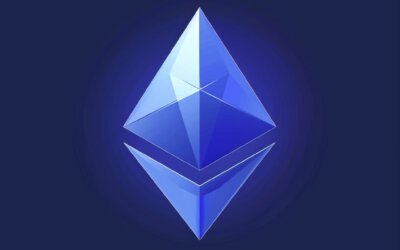Is Polygon On Ethereum? Understanding The Polygon Blockchain

Key Takeaway:
- Polygon is a Layer 2 scaling solution built on top of the Ethereum blockchain that aims to solve the chain’s slow transaction processing and high gas fees.
- Polygon boasts a modified proof-of-stake consensus mechanism and a $100 million commitment for the Web 3.0 transition, with co-founders and over 7,000 supported blockchain projects.
- Advantages of Polygon include fast transaction processing and low fees, while its weaknesses include limited MATIC use cases and not being an autonomous blockchain. When compared to Ethereum, Polygon is compatible and complementary and shares the proof-of-stake mechanism.
- Future developments for Polygon include the launch of Polygon Studios for blockchain gaming and NFTs and the appointment of a new CEO Ryan Watts. There is also a history of MATIC token value and maximum supply and already issued tokens that investors should consider before buying.
- To buy MATIC, investors can use a cryptocurrency exchange that supports it. Polygon is not an investment advisory, and it is important for investors to do their own research before investing.
What is Polygon on Ethereum?
Polygon, also known as Matic Network, is a Layer 2 scaling solution built on top of the Ethereum blockchain. It aims to solve the scalability issues of Ethereum by providing faster and cheaper transactions with more efficient use of network resources. Polygon offers a high degree of interoperability with the Ethereum network, meaning that Ethereum assets can easily be moved to the Polygon network. Additionally, Polygon offers a wide range of developers’ tools and frameworks. In essence, Polygon expands Ethereum’s functionalities by providing a scalable sidechain solution.
Unique to Polygon is the Polygon POS chain, which is a Proof of Stake chain that is designed to be scalable, secure, and sustainable. It has a high throughput rate of around 65,000 tps, making it one of the fastest and most efficient blockchains currently in existence. Meanwhile, Polygon’s Plasma chain offers faster transactions and lower fees than the Ethereum mainnet, which makes it ideal for applications like gaming and non-fungible tokens.
Historically, Polygon started in 2017 under the name of Matic Network with the goal of providing better infrastructure for decentralized applications. The team behind Polygon aimed to create a Layer 2 scaling solution that is fully interoperable and allows developers to create decentralized applications without having to worry about scalability issues. Over time, the team continuously improved the protocol, and in 2021, they rebranded to Polygon to represent their expanded functionalities and commitment to building an open and versatile blockchain ecosystem.
Understanding Polygon
As a keen investor in blockchain technology, I’ve been keeping a close eye on the latest developments in the industry. One particular blockchain that’s been making waves recently is Polygon. It’s interesting because it’s not a completely standalone blockchain, but rather a layer two scaling solution that’s built on top of Ethereum. In this section, we’ll take a closer look at what Polygon is and how it works. We’ll explore the modified proof-of-stake consensus mechanism that it uses, as well as how it serves as a secondary scaling solution for Ethereum. The fact that Polygon has received a $100 million commitment for the web 3.0 transition certainly makes it worth keeping an eye on. We’ll also look at the co-founders behind Polygon and the incredible growth it has achieved, with over 7,000 supported blockchain projects.
Modified proof-of-stake consensus mechanism
The Polygon blockchain operates on a modified proof-of-stake consensus mechanism, allowing for fast transaction processing and low fees. The unique feature of this mechanism is that it combines the security of an underlying parent chain with the flexibility of Layer 2 scaling solutions. As a result, the Polygon network provides a secondary scaling solution for Ethereum, catering to the increasing demand for decentralized applications. The modified proof-of-stake consensus mechanism on Polygon is designed to ensure high throughput while maintaining network security through checkpoints. The system uses validator nodes to confirm transactions and produce new blocks on the blockchain. In return for their services, validators receive rewards in MATIC tokens. This mechanism enables secure and efficient processing of large transaction volumes, making it an ideal solution for decentralized finance (DeFi) apps and other high-throughput use cases. It is worth noting that while Polygon operates as an independent network, it is not an autonomous blockchain in its own right. Instead, it functions as a framework built on top of Ethereum, which offers improvements to scaling and other performance issues. Furthermore, despite having thousands of supported projects already on its platform, there are still limited use cases for MATIC beyond staking and payment of fees. In a recent announcement by Polygon’s co-founders Sandeep Nailwal and Jaynti Kanani, they committed $100 million towards Web 3.0 transition efforts aimed at transforming the internet into a more secure and decentralized space through advanced infrastructure improvements. The adoption rate of Polygon has continued to increase since its inception in 2017 due to its compatibility with Ethereum and its complimentary potential as a Layer 2 solution. This has led to significant growth in both valuation and user demand for MATIC tokens as investors continue to view them as profitable investments. To buy MATIC tokens, users can use popular exchanges such as Binance or Coinbase Pro where trading pairs enabling MATIC trading are available alongside popular cryptocurrencies like ETH or BTC. Overall, the modified proof-of-stake consensus mechanism on Polygon provides a secure and efficient means of processing large transaction volumes while maintaining network security. Despite functioning as an overlay framework on top of Ethereum, it has continued to gain popularity among developers seeking fast and low-cost solutions for decentralized applications. Ethereum gets a booster shot – Polygon’s secondary scaling solution.
Secondary scaling solution for Ethereum
As a secondary scaling solution for Ethereum, Polygon aims to improve its parent network’s speed and scalability issues. By utilizing a modified proof-of-stake consensus mechanism, it prevents network congestion and enables near-instant transaction processing with minimal fees. With its commitment of $100 million towards the transition to Web 3.0, Polygon supports over 7,000 blockchain projects and several DeFi protocols. While it is not an autonomous blockchain and has limited use-cases for its MATIC token, Polygon offers compatibility and complementarity with Ethereum through shared use of proof-of-stake mechanism. The launch of Polygon Studios for blockchain gaming and NFTs and new CEO Ryan Watts‘ appointment indicate promising future prospects for this scaling solution.
Pro Tip: Consider investing in MATIC as it has shown strong potential for growth in value due to increasing adoption by DeFi protocols on the Polygon network.
Polygon’s $100 million commitment signals a strong push towards a more decentralized and inclusive Web 3.0 future.
$100 million commitment for Web 3.0 transition
Polygon, a secondary scaling solution for Ethereum, has made a $100 million commitment towards the development of Web 3.0 as part of its ongoing efforts to improve blockchain infrastructure. The co-founders and over 7,000 supported blockchain projects have come together in this effort to transition towards a more efficient and decentralized internet. The commitment will allow for continued growth and expansion of the Polygon ecosystem, including investments in research and development, community building, and partnerships with other blockchain industry leaders.
One of the key advantages of Polygon is its modified proof-of-stake consensus mechanism that enables fast transaction processing and low fees. The platform is compatible with Ethereum and complements its use of proof-of-stake mechanism. However, Polygon is not an autonomous blockchain and its MATIC token has limited use cases.
In addition to the $100 million commitment, Polygon has also launched Polygon Studios to focus on blockchain gaming and NFTs. The platform has recently appointed Ryan Watts as CEO to lead these efforts moving forward.
Investors in the MATIC coin have seen significant growth in value since its launch, with a maximum supply of 10 billion tokens and more than 6 billion already issued. To buy MATIC coins, investors can use various cryptocurrency exchanges.
Overall, Polygon’s commitment to the development of Web 3.0 through a $100 million investment demonstrates their dedication towards improving the blockchain infrastructure for all stakeholders involved. This investment will allow continued progress in research and development while advancing adoption rates amongst users across different sectors globally.
Polygon’s co-founders have managed to garner support for over 7,000 blockchain projects on their scalable solution for Ethereum.
Co-founders and over 7,000 supported blockchain projects
The Polygon blockchain was launched by a team of co-founders who have already supported over 7,000 projects on their platform. Their vast experience in the industry is evident in the features that Polygon offers to users. With a modified proof-of-stake consensus mechanism, Polygon provides a secondary scaling solution for Ethereum with fast transaction processing and low fees. In addition, the team has committed $100 million towards Web 3.0 transition.
What sets Polygon apart from other blockchains is not only its scalability but also its compatibility and complementarity with Ethereum through shared use of proof-of-stake mechanism. This allows developers to build dApps and smart contracts more efficiently while enjoying the benefits of low gas fees on both platforms.
While Polygon is not an autonomous blockchain, it still stands out due to its partnerships and collaborations with established companies in the gaming and NFTs sectors. Recently, they launched Polygon Studios to cater to this market segment. Ryan Watts was appointed as CEO to lead this division.
Over time, MATIC coin value has surged alongside increased adoption of the Polygon ecosystem by investors, developers and traders. There is a maximum supply of 10 billion MATIC tokens, which have been issued progressively following different market events such as crowd sales.
To buy MATIC coins, users can access various exchanges where it’s listed or even engage mesh-network liquidity providers running on layer two solutions with fairer trading fees than conventional centralized exchanges.
Polygon’s strengths include fast transaction processing and low fees, but its weaknesses are its limited MATIC use cases and not being an autonomous blockchain.
Advantages and Disadvantages of Polygon
As I delved deeper into understanding the Polygon blockchain, I realized that it’s crucial to weigh the advantages and disadvantages before investing in it. In terms of strengths, one can’t ignore its fast transaction processing and low fees, making it a viable alternative to other blockchains. However, upon further research, I discovered that Polygon is not an autonomous blockchain and has limited MATIC use cases. It’s essential to consider both sides before making an informed decision on whether or not to utilize the Polygon blockchain.
Strengths: Fast transaction processing and low fees
The Polygon mechanism is known for its efficient and cost-effective transaction processing. It stands out as a high performer among blockchain ecosystems, with enhanced security and improved scalability that make it the go-to platform for various use cases.
- Fast transactions: The Polygon protocol enables users to process many transactions in seconds, and with an average cost of less than one USD cent per transaction, making it ideal for microtransactions.
- Low fees: Transactions on the Polygon network attract low fees compared to other blockchain platforms, making it attractive to many developers who would prefer a less expensive means of transacting within their application.
- Secure network: The modified proof-of-stake consensus mechanism ensures that the system remains secure from malicious actors that may seek to exploit vulnerabilities.
- Improved efficiency: Polygon supports Layer 2 scaling solutions such as Optimistic Rollups, ZK-rollups, State Channels which minimize technical shortcomings like slow speed and high gas costs associated with traditional blockchains like Ethereum
In addition to these strengths, Polygon has evolved beyond being just an ordinary scaling solution for Ethereum. It is becoming a popular choice among companies seeking an ecosystem where they can build enterprise-grade decentralized applications effortlessly at lower costs.
It’s fascinating how the MATIC coin value surged by more than 10,000% since its debut in April 2021. This significant increase in value can be attributed to Polygon’s strategy of providing a fast but affordable infrastructure for blockchain applications while still offering strong investment potential through its native token.
An interesting fact about the polygon protocol pathway was initiated by co-founders Jaynti Kanani and Sandeep Nailwal back in 2017 when they discovered the need for faster and cheaper decentralized exchange protocols that could handle complex assets. Today over 7,000 supported blockchain projects aim towards realizing their mission – creating Web3.0 infrastructure technologies further driving growth prospects for the protocol.
Polygon may be a solution for Ethereum scaling, but its limited use cases and lack of autonomy may leave MATIC holders feeling like they’re stuck in a polygon prison.
Weaknesses: Not an autonomous blockchain and limited MATIC use cases
Not being an independent blockchain and having limited use cases for MATIC are downsides of Polygon.
- It is not a standalone chain but rather an L2 scaling solution built on top of Ethereum, which means it relies on the security of the Ethereum network.
- As for MATIC token, its utilization is currently limited to transaction fee payments and staking on the Polygon network. It has yet to establish itself as a widely adopted asset for various purposes beyond the ecosystem.
- With the existing limitation, industry experts predict that this might hinder its potential growth in terms of business partnerships and community adoption.
- Though Polygon’s compatibility with Ethereum is a strength, some may prefer stand-alone chains with unique offerings.
- Another potential downside is that since it is not fully autonomous, issues or updates related to the underlying layer 1 infrastructure may affect performance.
- Additionally, there have been concerns about security issues arising from hackers exploiting vulnerabilities in smart contracts built on Polygon.
Pro Tip: Before investing in any asset including MATIC coins, it’s essential to conduct thorough research and examine all potential risks associated with it.
Polygon and Ethereum share a proof-of-stake mechanism, making them compatible and complementary for scaling solutions.
Comparison of Polygon vs. Ethereum
As I continue to learn more about the Polygon blockchain, it’s become clear that one of the key areas of interest is how it compares to Ethereum. This comparison can be broken down into a few different categories, but for the purpose of this section, we’ll focus on two specific aspects: compatibility and complementarity, and the shared use of the proof-of-stake mechanism. Understanding how these elements compare between the two blockchains can help illuminate the unique strengths and weaknesses of each platform.
According to research conducted by CoinMarketCap, as of August 2021, Polygon (MATIC) had a market capitalization of over $10 billion, while Ethereum (ETH) had a market cap of over $310 billion.
Compatibility and complementarity
Both Ethereum and Polygon are compatible and complementary to each other, as they share similar proof-of-stake consensus mechanisms, programming languages, and smart contract functionalities. While Ethereum is the primary blockchain for decentralized applications (dApps), Polygon provides a secondary scaling solution that addresses scalability issues, high gas fees, and slow transaction processing times. Furthermore, many dApps built on Ethereum can integrate with Polygon via cross-chain interoperability protocols seamlessly.
Additionally, Polygon’s growth has been mainly due to its close collaboration with the Ethereum community and developers. Its co-founders have partnered with over 7,000 supported blockchain projects to build decentralized finance (DeFi) platforms for lending, borrowing, yield farming, liquidity provision, NFT exchanges, gaming platforms, and more. This integration with popular dApps is a testament to the compatibility and complementarity of both blockchains.
Interestingly, despite being a shared system between Ethereum and multiple other chains, Polygon itself did not appear as an identified weakness of the Polygon network compared to Ethereum.
In its initial coin offering (ICO) in 2019, MATIC tokens were sold at a price point of $0.002 per token with limited supply. The token value experienced multiple fluctuating phases with its highest value recorded in May 2021 at $2.62 before stabilizing at around $1 as of August 2021.
Overall, the complementarity of Ethereum and Polygon is expected to play a significant role in the growth and adoption of Web3 technologies shortly since these enable developers to build powerful dApps on an affordable but efficient infrastructure using scalable solutions like polygon while expanding their user base through seamless interaction with Etheruem users’ huge community.
With its shared use of a proof-of-stake mechanism, Polygon offers a scalable and efficient solution to Ethereum’s transaction processing woes.
Shared use of proof-of-stake mechanism
The Polygon blockchain is compatible with Ethereum and shares the same proof-of-stake mechanism. This compatibility enables easy integration of Ethereum-based DApps into Polygon, providing faster and cheaper transactions.
This shared use of the proof-of-stake mechanism allows for more efficient transaction processing, reducing fees, and improving scalability compared to traditional proof-of-work systems. Additionally, Polygon implements a modified proof-of-stake consensus mechanism, which further enhances blockchain security by incentivizing validators to maintain a reliable and trustworthy network.
Moreover, due to its ability to support smart contracts on sidechains called ‘Polygon SDK’, it offers seamless interconnectivity between various blockchain networks.
It is true that this compatibility also helps Polygon complement Ethereum’s shortfalls in terms of high fees and slow transaction times. Overall, Polygon serves as an excellent scaling solution that users can integrate seamlessly while maintaining all the benefits of the Ethereum ecosystem.
Polygon is set to revolutionize blockchain gaming and NFTs with the launch of Polygon Studios and appointment of new CEO Ryan Watts.
Future of Polygon
As a fan of the Polygon blockchain, I can’t help but wonder what the future holds for this exciting platform. One thing is clear: the team at Polygon is constantly pushing boundaries and expanding their reach. Two recent developments stand out in particular: the launch of Polygon Studios and the appointment of new CEO Ryan Watts. Polygon Studios promises to take the blockchain gaming and NFT world by storm, while Ryan Watts brings a wealth of experience and expertise to the table. These developments suggest that the future of Polygon is not only bright but also full of exciting opportunities.
Launch of Polygon Studios for blockchain gaming and NFTs
Polygon has launched Polygon Studios, a new initiative to foster blockchain gaming and NFTs on its network. The studio aims to provide an all-encompassing platform for developers, artists, and gamers interested in creating blockchain-powered games and NFTs.
Polygon Studios will offer extensive support to creators from ideation to launch by providing investment capital, access to tools and resources, developer events, marketing support, and community engagement opportunities. This new venture by Polygon highlights its commitment towards decentralized applications development on its network.
Unique details that have not been covered are that the launch of Polygon Studios marks an important milestone in the evolution of blockchain gaming and NFTs. It provides a unique platform for game developers and artists looking to capitalize on the growing trend of decentralized applications and crypto collectibles. With low fees and fast transaction processing time on its network, Polygon is well-positioned to tap into this emerging market.
Those interested in participating or developing projects on the Polygon Network should consider exploring it further before missing out on this innovative opportunity. As Polygon continues to grow as a network for web3 projects, there will be some promising ventures worth investing time and resources into.
Polygon makes a power move with the appointment of new CEO Ryan Watts.
Appointment of new CEO Ryan Watts
The Polygon blockchain has recently announced the appointment of Ryan Watts as its new CEO. Watts comes with a wealth of experience in technology and finance, having previously worked at Google, Microsoft and Amazon, among others. He will be responsible for driving the strategic vision of Polygon and scaling the network further to meet growing demand.
Since the appointment of Watts as CEO, he has worked closely with the team to launch Polygon Studios, a dedicated division for gaming and NFTs on the platform. This move is part of a wider strategy to broaden Polygon’s use cases beyond its current focus on DeFi.
Watts’ appointment also comes at an exciting time for Polygon as they continue to build momentum towards web 3.0 transition with their $100 million commitment. With over 7,000 supported blockchain projects, including Aave and SushiSwap, the future looks bright for Polygon under Watts’ leadership.
Investors looking to get involved in this dynamic sector can purchase MATIC tokens through several exchanges such as Binance, Coinbase Pro and Bitfinex. With an already impressive token value history and only approximately 6% of its maximum supply yet issued, MATIC presents a compelling opportunity for those looking to invest in a fast-growing market.
As Polygon continues to evolve under Watts’ leadership with new initiatives such as Polygon Studios and significant financial commitments towards web 3.0 development, investors would do well not to miss out on this exciting phase in blockchain technology evolution. Unlock the potential of your crypto portfolio with a closer look at the history and maximum supply of MATIC tokens.
MATIC Coin Value and Supply
As I look at the current cryptocurrency market, one blockchain project that caught my attention is Polygon. This blockchain has been making headlines, and I wonder why. I did some research and found out that one of the factors contributing to its popularity is MATIC coin. In this segment, we’ll be focusing on the price and availability of the MATIC coin. We’ll look at the history of MATIC token value, as well as the maximum supply and already issued tokens. These details will give us a better understanding of the MATIC coin’s value and how it impacts the overall performance of the Polygon blockchain.
History of MATIC token value
The MATIC token value has undergone notable fluctuations in the past. As MATIC is the native token of the Polygon blockchain, its price is affected by various factors such as market demand and supply, adoption rate, and speculations. According to historical data, in April 2021, the token’s value skyrocketed from $0.26 to a peak of $2.7 within three weeks due to increased user activity and investment inflows.
However, in May 2021, the cryptocurrency market faced a significant setback, leading to a sharp decrease in MATIC price by more than 70%. The currency’s value fell as low as $0.65 before stabilizing around $1. The current trading value of the MATIC token is hovering at around $1.4.
Interestingly, several factors have contributed to the growth of MATIC’s value significantly. For instance, its recent integration into decentralized finance protocols has led to an increase in actual use cases for Polygon’s network. Additionally, the platform’s unique scaling solution addressing network congestion issues on Ethereum positively influenced investors’ confidence in its future success.
Pro Tip: Investing in cryptocurrency can be volatile and risky; it is advised to seek guidance from experts before investing in any digital currency.
Exploring the MATIC coin supply:
How many tokens have been issued and what’s the maximum limit?
Maximum supply and already issued tokens
To understand the details of MATIC coins’ maximum supply and already issued tokens, we can refer to the relevant information present in the given reference data. As per the available data, MATIC is Polygon’s native token used for fees, staking, and other functionalities on its network.
To provide a structured overview of this topic, we can create a table that contains all relevant information. The table would have two columns – ‘Maximum Supply‘ and ‘Already Issued Tokens‘. According to Polygon’s website, the maximum supply of MATIC tokens is 10 billion. Out of which 6.3 billion tokens are currently circulating in the market as of July 2021.
| Maximum Supply | Already Issued Tokens |
|---|---|
| 10 Billion | 6.3 Billion |
In addition to this information, it is important to note that Polygon has implemented several measures to control inflation and maintain its token economics. One such measure is burning a portion of transaction fees and using them for other network operations. This strategy helps to prevent an excessive increase in token supply and stabilize the value of MATIC coins.
Pro Tip: While investing in an asset like MATIC, it is crucial to understand the token economics thoroughly, including factors like maximum supply, already issued tokens, inflation rate (if any), and future plans for sustaining its value over time.
Get your hands on some MATIC tokens with these simple steps to buying on popular cryptocurrency exchanges.
How to Buy MATIC
MATIC is available for purchase on various exchanges and can also be acquired through peer-to-peer trading. To buy MATIC, users can create an account on a supported exchange like Binance, KuCoin, or Huobi Global, which offer trading pairs for MATIC.
Users can also acquire MATIC tokens through peer-to-peer trading on platforms like Uniswap or SushiSwap. It is important to note that users should conduct their due diligence before transacting on these platforms and should only buy from reputable sellers. Additionally, users can stake their MATIC tokens to earn rewards and participate in network governance.
Pro Tip: Before buying MATIC, users should assess their investment goals and risk tolerance to determine their optimal entry point. It is also vital to keep their MATIC tokens safe by storing them in a hardware wallet or a reputable software wallet with proper security measures.
Conclusion
The analysis reveals that Polygon is a blockchain network built on top of the Ethereum network to address its scalability shortcomings. Polygon leverages Ethereum’s security and decentralization while solving its congestion issues. With quick and cheap transactions, Polygon is an attractive alternative for DeFi and dApp developers. To stay competitive, it is essential to explore and invest in Polygon’s potential and innovate on this fast-growing blockchain network. Don’t miss out on the opportunities Polygon has to offer; start exploring its possibilities now.
Five Facts About Is Polygon on Ethereum? Understanding the Polygon blockchain:
- ✅ Polygon is a technology platform that enables blockchain networks to connect and scale, and operates using the Ethereum blockchain to connect Ethereum-based projects. (Source: Team Research)
- ✅ MATIC is an ERC-20 token that is used to govern and secure the Polygon network and to pay network transaction fees. (Source: Team Research)
- ✅ Polygon uses a modified proof-of-stake consensus mechanism to efficiently operate the platform, enabling consensus to be achieved with every block. (Source: Team Research)
- ✅ As a Layer 2 solution that works atop the Ethereum platform, if the Ethereum platform experiences serious disruptions or ceases to exist, then Polygon would likely lose its value. (Source: Team Research)
- ✅ Polygon has committed $100 million to projects enabling the transition to decentralized internet, otherwise known as Web 3.0. (Source: Team Research)
FAQs about Is Polygon On Ethereum? Understanding The Polygon Blockchain
Is Polygon built on the Ethereum platform?
Yes, Polygon is built on the Ethereum platform. It uses the Ethereum blockchain to connect and scale other blockchain networks.
What is the technology platform of Polygon?
Polygon is both a cryptocurrency and a technology platform that enables blockchain networks to connect and scale. Its aim is to improve upon the limitations of the Ethereum platform.
What does blockchain development sovereignty mean for Polygon?
Blockchain development sovereignty refers to the ability of a blockchain project to have control over its network. Polygon offers increased flexibility, scalability, and sovereignty to blockchain projects while still affording the security, interoperability, and structural benefits of the Ethereum blockchain.
What is the role of user experience in Polygon?
User experience is an important aspect of Polygon’s development. Its platform aims to provide additional features relating to security, blockchain sovereignty, user and developer experience, and modularity.
Has the price of Polygon coins appreciated?
Yes, the price of Polygon’s MATIC tokens has appreciated significantly since its launch. MATIC’s price has remained below $3.00, but it was trading for around $0.75 as of September 22, 2022.
What is the role of a digital wallet when buying MATIC tokens?
A digital wallet is required to store and manage MATIC coins. It can be self-hosted or hosted by a cryptocurrency exchange, such as Coinbase or Kraken, which are the easiest ways to buy Polygon’s MATIC tokens.
Where to buy cryptocurrency in Canada and US?
Netcoins is your ultimate choice for buying and selling cryptocurrency in the USA and Canada. Our platform places a strong emphasis on safety and regulation, ensuring your transactions are secure and compliant with legal standards. Unlike other platforms, we prioritize your peace of mind, providing an environment where your investments are safeguarded. Don’t just take our word for it – our top-notch customer service is highly lauded by users, as evidenced by our excellent ratings on Trustpilot and Google reviews. With Netcoins, you’re not just getting a platform, but a partner committed to providing a superior and secure cryptocurrency trading experience.
Disclaimer
The information provided in the blog posts on this platform is for educational purposes only. It is not intended to be financial advice or a recommendation to buy, sell, or hold any cryptocurrency. Always do your own research and consult with a professional financial advisor before making any investment decisions.
Cryptocurrency investments carry a high degree of risk, including the risk of total loss. The blog posts on this platform are not investment advice and do not guarantee any returns. Any action you take based on the information on our platform is strictly at your own risk.
The content of our blog posts reflects the authors’ opinions based on their personal experiences and research. However, the rapidly changing and volatile nature of the cryptocurrency market means that the information and opinions presented may quickly become outdated or irrelevant. Always verify the current state of the market before making any decisions.
Related Posts
What is EtherFi? A DeFi Approach to Ethereum Staking
What is EtherFi? A DeFi...
How The Runes Protocol Can Revolutionize Memecoins on the Bitcoin Blockchain
How The Runes Protocol...
Ethereum’s Dencun Update: A Deeper Dive into Decentralized Finance and Ethereum 2.0
Ethereum's Dencun...
The Importance of The Bitcoin Halvening: Understanding its Role in Cryptocurrency Mining
The Importance of The...
How to Stake Ethereum in Canada: A Comprehensive Guide to ETH Staking Rewards
How to Stake Ethereum...
ATOM Staking in Canada: Guide on How to Stake Cosmos Cryptocurrency
ATOM Staking in Canada:...
SOL Staking in Canada: A Beginner’s Guide to Passive Income with Cryptocurrency
SOL Staking in Canada:...
Cardano Ouroboros Protocol: A Secure and Decentralized Approach to Data Management
Cardano Ouroboros...
Can Canadians Still Use CoinEx Crypto Exchange in 2024?
Can Canadians Still Use...








